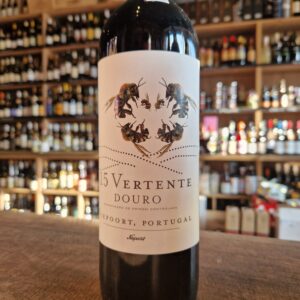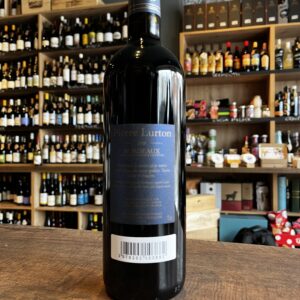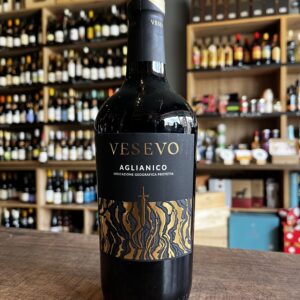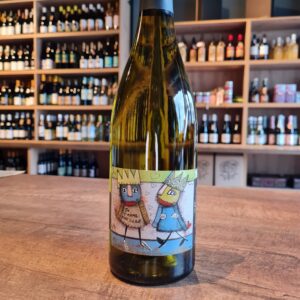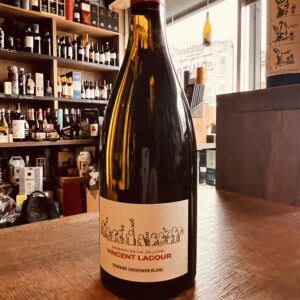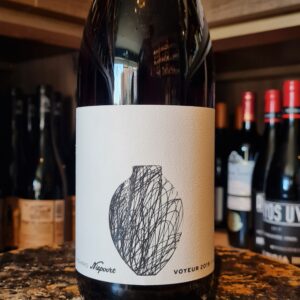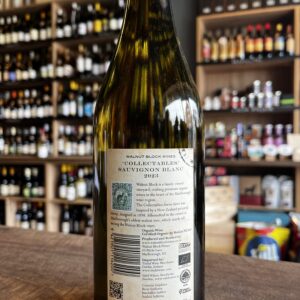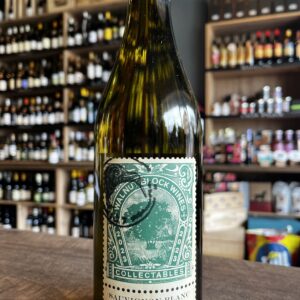-
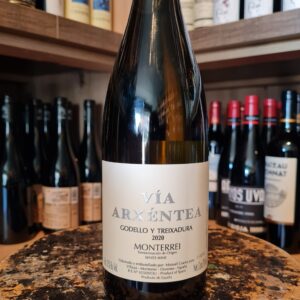 DO Monterrei is the smallest of the Galician DOs and the most recent, having been created in 1996. It is an emerging region located in the province of Ourense in the south-east of Galicia, on the border with Portugal. The Atlantic influence here is not as strong and the climate is hotter and more continental than the rest of Galicia, making it possible to produce impressive whites from Treixadura and Godello as well as reds from autochtonous Mencia. Most of the vineyards are located on the slopes lining the River Támega where the soil has a deep red colour with a high clay content. After spending many years working for other wineries in the area around Galicia, Manuel Guerra Justo decided to break away and set up his own adega, “Via Arxentea”, literally translated as “ The Silver Route”, the local name for the important pilgrimage route of El Camino de Santiago to Santiago de Compostela. Manuel Guerra is a “Colleitero” and therefore responsible for the entire production cycle, from the care in the vineyard to the winemaking. He is the first to acknowledge that the secret to achieving purity and varietal expression in his wines is in his vineyard management which he attends to personally and pampers vine by vine as if they were his own children, with the sole objective of achieving maximum quality. Under the consultancy of well known winemaker, Alvaro Bueno, Manuel Guerra Justo owns four hectares around Verin, planted almost equally between Godello and Treixadura and a small batch of Mencia. Vía Arxentea wine are made from estate bottled fruit, harvested by hand and fermented using indigenous yeasts.
DO Monterrei is the smallest of the Galician DOs and the most recent, having been created in 1996. It is an emerging region located in the province of Ourense in the south-east of Galicia, on the border with Portugal. The Atlantic influence here is not as strong and the climate is hotter and more continental than the rest of Galicia, making it possible to produce impressive whites from Treixadura and Godello as well as reds from autochtonous Mencia. Most of the vineyards are located on the slopes lining the River Támega where the soil has a deep red colour with a high clay content. After spending many years working for other wineries in the area around Galicia, Manuel Guerra Justo decided to break away and set up his own adega, “Via Arxentea”, literally translated as “ The Silver Route”, the local name for the important pilgrimage route of El Camino de Santiago to Santiago de Compostela. Manuel Guerra is a “Colleitero” and therefore responsible for the entire production cycle, from the care in the vineyard to the winemaking. He is the first to acknowledge that the secret to achieving purity and varietal expression in his wines is in his vineyard management which he attends to personally and pampers vine by vine as if they were his own children, with the sole objective of achieving maximum quality. Under the consultancy of well known winemaker, Alvaro Bueno, Manuel Guerra Justo owns four hectares around Verin, planted almost equally between Godello and Treixadura and a small batch of Mencia. Vía Arxentea wine are made from estate bottled fruit, harvested by hand and fermented using indigenous yeasts. -
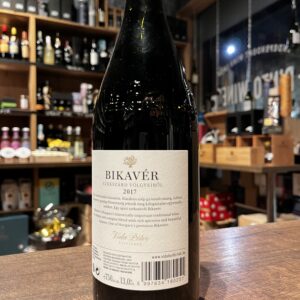
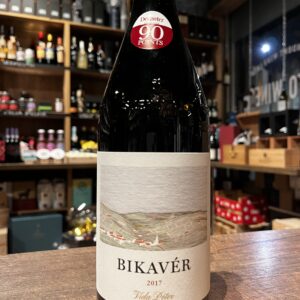 Bikaver is a Hungarian blend based on Kékfrankos and Kadarka. The two local grapes must together make up at least 50% of the blend, while oak should be used sparingly. Szekszárdi Bikavér is generally medium ruby in colour with pronounced fruit and spice, vibrant acidity and silky, velvety tannins. Its aromatics are characterised by spice, paprika, mint, hibiscus and rosemary as well as red berry fruit, cherry, raspberry and plum. Kékfrankos provides the blend’s backbone, freshness, acidity and pronounced yet silky tannins. While Kadarka is responsible for its floral, spicy notes, which add bewitching lightness to the wine. Of course, as always, much depends on the winemaker’s style too, but what is certain is that Szekszárdi Bikavér is a truly appealing, elegant wine, which speaks of the place of origin.
Bikaver is a Hungarian blend based on Kékfrankos and Kadarka. The two local grapes must together make up at least 50% of the blend, while oak should be used sparingly. Szekszárdi Bikavér is generally medium ruby in colour with pronounced fruit and spice, vibrant acidity and silky, velvety tannins. Its aromatics are characterised by spice, paprika, mint, hibiscus and rosemary as well as red berry fruit, cherry, raspberry and plum. Kékfrankos provides the blend’s backbone, freshness, acidity and pronounced yet silky tannins. While Kadarka is responsible for its floral, spicy notes, which add bewitching lightness to the wine. Of course, as always, much depends on the winemaker’s style too, but what is certain is that Szekszárdi Bikavér is a truly appealing, elegant wine, which speaks of the place of origin. -
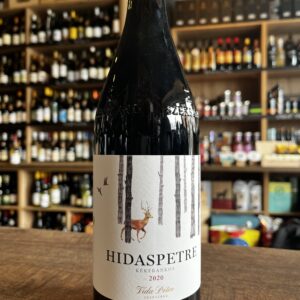 Single vineyard Kekfrankos from Szekszard. The valley of Hidaspetre is surrounded by forest, where the countryside is loud with the singing of birds at dawn. Our vineyard selection is an elegant and beautifully balanced wine with refreshing tannins. Soil: calcareous loess soil with red clay Cultivation method, load: low cordon, 40-50 hl/ha Harvest: September 22-24, 2020
Single vineyard Kekfrankos from Szekszard. The valley of Hidaspetre is surrounded by forest, where the countryside is loud with the singing of birds at dawn. Our vineyard selection is an elegant and beautifully balanced wine with refreshing tannins. Soil: calcareous loess soil with red clay Cultivation method, load: low cordon, 40-50 hl/ha Harvest: September 22-24, 2020 -
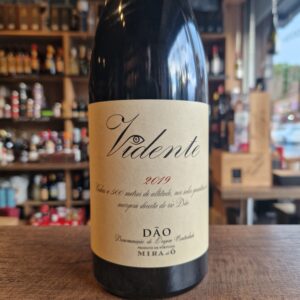 This wine rises from 500 meters above sea level in the granite soils of the right bank of the Dão. These low yield vines are about 30 years old and produce high quality grapes of the varieties Jaen, Alfrocheiro, Tinta Pinheira, Tinta Roriz and Touriga Nacional. This wine is a very personal vision over the Dão and its wines, enhancing the elegance and freshness that are natural to this region. True value in wine. Food orientated but aren't all the wines?
This wine rises from 500 meters above sea level in the granite soils of the right bank of the Dão. These low yield vines are about 30 years old and produce high quality grapes of the varieties Jaen, Alfrocheiro, Tinta Pinheira, Tinta Roriz and Touriga Nacional. This wine is a very personal vision over the Dão and its wines, enhancing the elegance and freshness that are natural to this region. True value in wine. Food orientated but aren't all the wines? -
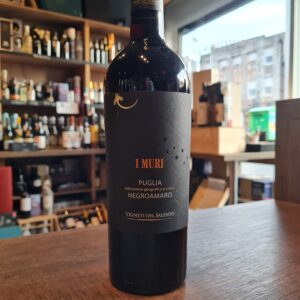 Great value wine from Puglia. This is Farnese’s venture in Puglia. The wines are made at two wineries in the province of Taranto on the western flank of Salento. The style of the wines - fresh whites, soft and generous reds - will be familiar to those who buy their other wines, as winemaker Filippo Baccalaro is the driving force behind this label. Filippo, a native of Piemonte, has been working in Puglia for almost two decades. He was attracted by the rich, ripe flavours of the fruit, and has the potential to capture these flavours with minimal use of technology and a lot of know-how. The vineyards are mostly situated in the communes of Manduria and Sava and are owned by growers with whom Filippo has been working for many years. Production is lower than its potential, which ensures the best quality grapes are selected. The red soils are calcerous clay and rich in iron, minerals and nutrients. 80% of the grapes come from old bush vines and the rest from trained vines that are at least 20 years old. Spring was colder than usual, and this slowed down budbreak and flowering. May and June followed with above average rainfall. Despite this, the Mistral and the north wind persisted for more than 30 days and this allowed vines to keep healthy during the ripening phase delivering extraordinary quality but with 20% lower yields. Enjoy with Pastas, cheeses, Chicken dishes and some not too rich red meats
Great value wine from Puglia. This is Farnese’s venture in Puglia. The wines are made at two wineries in the province of Taranto on the western flank of Salento. The style of the wines - fresh whites, soft and generous reds - will be familiar to those who buy their other wines, as winemaker Filippo Baccalaro is the driving force behind this label. Filippo, a native of Piemonte, has been working in Puglia for almost two decades. He was attracted by the rich, ripe flavours of the fruit, and has the potential to capture these flavours with minimal use of technology and a lot of know-how. The vineyards are mostly situated in the communes of Manduria and Sava and are owned by growers with whom Filippo has been working for many years. Production is lower than its potential, which ensures the best quality grapes are selected. The red soils are calcerous clay and rich in iron, minerals and nutrients. 80% of the grapes come from old bush vines and the rest from trained vines that are at least 20 years old. Spring was colder than usual, and this slowed down budbreak and flowering. May and June followed with above average rainfall. Despite this, the Mistral and the north wind persisted for more than 30 days and this allowed vines to keep healthy during the ripening phase delivering extraordinary quality but with 20% lower yields. Enjoy with Pastas, cheeses, Chicken dishes and some not too rich red meats -
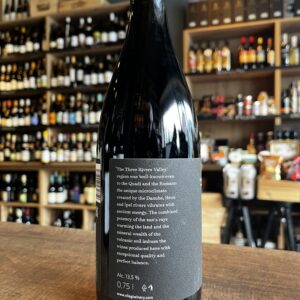
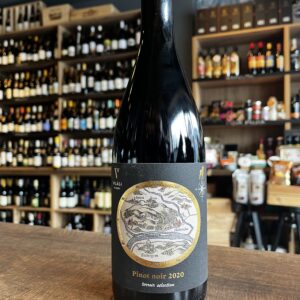 Organically cultivated Pinot Noir on a mineral rich volcanic bedrock in the Three Rivers Valley. Old world mineral freshness is paired with ripe flavour intensity that of New World Pinot Noirs. Fermented and aged in 2nd fill 500l Hungarian barrels for 24months. Forest fruits, juicy ripe cherries, well integrated silky oak tannins. Tastes luxurious.
Organically cultivated Pinot Noir on a mineral rich volcanic bedrock in the Three Rivers Valley. Old world mineral freshness is paired with ripe flavour intensity that of New World Pinot Noirs. Fermented and aged in 2nd fill 500l Hungarian barrels for 24months. Forest fruits, juicy ripe cherries, well integrated silky oak tannins. Tastes luxurious. -
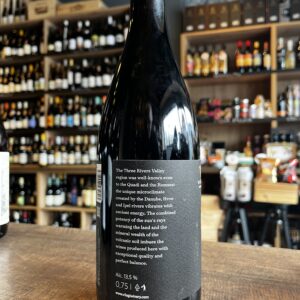
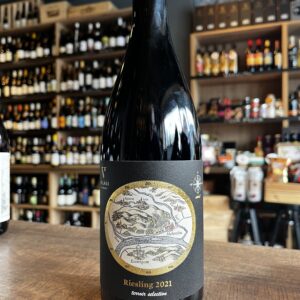 Organically cultivated Riesling on a mineral rich volcanic bedrock in the Three Rivers Valley. The Danube, Ipel and Hron rivers create a uniquely refreshing microclimate well suited to Riesling. Fermented in 500l Hungarian barrels then matured on the lees for 9 months in stainless steel, this is an immensly complex white with excellent ageing potential. The quality of the terroir paired with exceptional winemaking skills surpasses even some of the most prestigious German Rieslings. Lean, bone-dry and a layered flavour profile, with a classic Riesling character developing towards tertiary notes.
Organically cultivated Riesling on a mineral rich volcanic bedrock in the Three Rivers Valley. The Danube, Ipel and Hron rivers create a uniquely refreshing microclimate well suited to Riesling. Fermented in 500l Hungarian barrels then matured on the lees for 9 months in stainless steel, this is an immensly complex white with excellent ageing potential. The quality of the terroir paired with exceptional winemaking skills surpasses even some of the most prestigious German Rieslings. Lean, bone-dry and a layered flavour profile, with a classic Riesling character developing towards tertiary notes. -
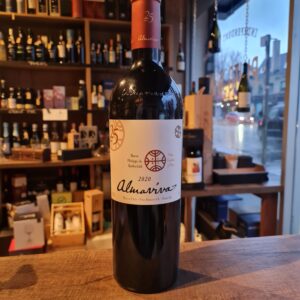 To celebrate the estate's 25th anniversary, the 2020 vintage by Almaviva is adorned with a special "25 años" label. Viña Almaviva was founded in 1997 following the collaboration between Baroness Philippine de Rothschild and Don Alfonso Larrain, President of Viña Concha y Toro. The Viña Almaviva project gives rise to fine Chilean wines that benefit from a rich French winemaking know-how and the unique expression of this Central Valley terroir. The name Almaviva, though it has an Hispanic sonority, belongs to classical French literature: Count Almaviva is the hero of The Marriage of Figaro, the famous play by Beaumarchais (1732-1799), later turned into an opera by the genius of Mozart. The label, meanwhile, pays homage to Chile’s ancestral history, with three reproductions of a stylized design, which symbolizes the vision of the earth and the cosmos in the Mapuche civilization. The design appears on the kultrun, a ritual drum used by the Mapuche. The label bears the name Almaviva in Beaumarchais’ own handwriting. Two great traditions thus join hands to offer the whole world a promise of pleasure and excellence. Located in the heart of the beautiful Maipo Valley, the Almaviva vineyard covers 50 hectares. The emblematic Bordeaux grape varieties thrive in this exceptional terroir. Almaviva has now become an essential reference for fine Chilean wines throughout the world. A particularly dry year, 2020 began with a cool, dry winter, resulting in a late budburst, particularly during the first two weeks of October. The spring and summer were marked by high temperatures but also by drought. These conditions favoured a rapid maturation of the vineyard and an early harvest, which ended three to four weeks earlier than in recent years. Despite this extreme climate and thanks to the rigour of the teams, the 2020 vintage reveals a fruity structure, a fresh expression and a rare tension.
To celebrate the estate's 25th anniversary, the 2020 vintage by Almaviva is adorned with a special "25 años" label. Viña Almaviva was founded in 1997 following the collaboration between Baroness Philippine de Rothschild and Don Alfonso Larrain, President of Viña Concha y Toro. The Viña Almaviva project gives rise to fine Chilean wines that benefit from a rich French winemaking know-how and the unique expression of this Central Valley terroir. The name Almaviva, though it has an Hispanic sonority, belongs to classical French literature: Count Almaviva is the hero of The Marriage of Figaro, the famous play by Beaumarchais (1732-1799), later turned into an opera by the genius of Mozart. The label, meanwhile, pays homage to Chile’s ancestral history, with three reproductions of a stylized design, which symbolizes the vision of the earth and the cosmos in the Mapuche civilization. The design appears on the kultrun, a ritual drum used by the Mapuche. The label bears the name Almaviva in Beaumarchais’ own handwriting. Two great traditions thus join hands to offer the whole world a promise of pleasure and excellence. Located in the heart of the beautiful Maipo Valley, the Almaviva vineyard covers 50 hectares. The emblematic Bordeaux grape varieties thrive in this exceptional terroir. Almaviva has now become an essential reference for fine Chilean wines throughout the world. A particularly dry year, 2020 began with a cool, dry winter, resulting in a late budburst, particularly during the first two weeks of October. The spring and summer were marked by high temperatures but also by drought. These conditions favoured a rapid maturation of the vineyard and an early harvest, which ended three to four weeks earlier than in recent years. Despite this extreme climate and thanks to the rigour of the teams, the 2020 vintage reveals a fruity structure, a fresh expression and a rare tension. -
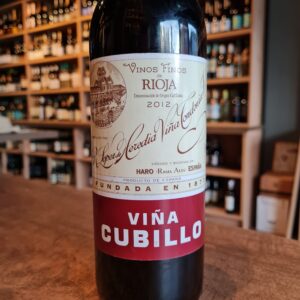 Viña Cubillo wines come from the vineyard called Viña Cubillas, some 4 km away from the bodega, which as with all of the other vineyards, was bought by our founder. Historically these wines were called "Special Harvest". For 143 years, four generations of the López de Heredia family have devoted themselves to producing exceptional and unique wines. Masterpieces which have achieved that which the founder of the company, Rafael López de Heredia y Landeta, defined in the late nineteenth century as the "Supreme Rioja". Vineyard care, a scrupulous selection of grapes, ageing in oak barrels in the heart of deep underground galleries, and the later ageing in bottles, all contribute to making these illustrious wines with their exceptional bouquet. Decant it for an hour if possible, It goes perfectly with all meat dishes, tapas and assorted antipasti, sausages, small game and wild mushrooms.
Viña Cubillo wines come from the vineyard called Viña Cubillas, some 4 km away from the bodega, which as with all of the other vineyards, was bought by our founder. Historically these wines were called "Special Harvest". For 143 years, four generations of the López de Heredia family have devoted themselves to producing exceptional and unique wines. Masterpieces which have achieved that which the founder of the company, Rafael López de Heredia y Landeta, defined in the late nineteenth century as the "Supreme Rioja". Vineyard care, a scrupulous selection of grapes, ageing in oak barrels in the heart of deep underground galleries, and the later ageing in bottles, all contribute to making these illustrious wines with their exceptional bouquet. Decant it for an hour if possible, It goes perfectly with all meat dishes, tapas and assorted antipasti, sausages, small game and wild mushrooms. -
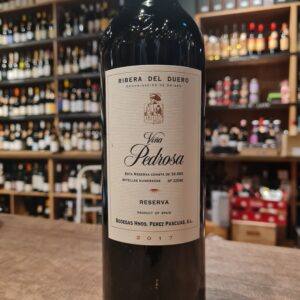 Bodegas Hnos. Perez Pascuas is a winery founded in 1980 and located in Pedrosa de Duero. In its vineyards, Tinta del País or Tempranillo predominate, and they also have a little Cabernet Sauvignon. They produce around 500,000 bottles. They also have a large collection of 3,000 barrels. The barrels are renewed every 3 years to maintain the contribution of compounds from the wood, and the toasted elements that characterise the style of the winery. Viña Pedrosa Reserva is an iconic wine from Pedrosa de Duero. A complex, powerful and highly expressive wine
Bodegas Hnos. Perez Pascuas is a winery founded in 1980 and located in Pedrosa de Duero. In its vineyards, Tinta del País or Tempranillo predominate, and they also have a little Cabernet Sauvignon. They produce around 500,000 bottles. They also have a large collection of 3,000 barrels. The barrels are renewed every 3 years to maintain the contribution of compounds from the wood, and the toasted elements that characterise the style of the winery. Viña Pedrosa Reserva is an iconic wine from Pedrosa de Duero. A complex, powerful and highly expressive wine -
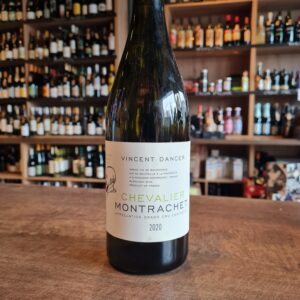
Few winemakers affirm their stellar reputation as convincingly as Vincent Dancer with his ethereal Chevalier Montrachet Grand Cru Blanc 2020. Immaculately crafted in the revered vineyards of France's Burgundy region, it is an unparalleled masterpiece from one of the region's mavericks.
Going against the grain of traditional Burgundian winemaking, Vincent Dancer opts for no battonage and low usage of new oak in producing this Grand Cru Blanc. He relies on sustainable viticulture practices, underscoring nature's ability to produce a near mystical balance of flavours without intervention. This purity of approach culminates in an elegant, nuanced white experienced in this bottle.
-
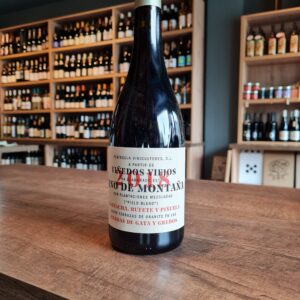 Vinos de Montaña is from a range of mountain wines on high-altitude vineyards in Sierra de Gredos and other historic growing areas in the Sistema Central, the mountain chain that divides the Iberian Peninsula in its Northern and Southern halves. Based mostly on very old Garnacha vines on granite soil, the wines are perfumed, delicate and fresh, displaying the character of their vineyard parcels and villages. This organic wine even though is from a recent created bodega/company, is from old vines revived in the mountain where wine was produced for decades. The Spanish market seemed to picked up on it, as it is becoming increasingly popular with the new enthusiastic wine drinkers generation. Recommended pairing with grilled vegetables, sausages, roasted meats, small game, cured cheeses.
Vinos de Montaña is from a range of mountain wines on high-altitude vineyards in Sierra de Gredos and other historic growing areas in the Sistema Central, the mountain chain that divides the Iberian Peninsula in its Northern and Southern halves. Based mostly on very old Garnacha vines on granite soil, the wines are perfumed, delicate and fresh, displaying the character of their vineyard parcels and villages. This organic wine even though is from a recent created bodega/company, is from old vines revived in the mountain where wine was produced for decades. The Spanish market seemed to picked up on it, as it is becoming increasingly popular with the new enthusiastic wine drinkers generation. Recommended pairing with grilled vegetables, sausages, roasted meats, small game, cured cheeses. -
Out of stock
 Villa Raiano was founded in 1996 in the old factories of the Basso family's oil mill, owner of the company in the Raiano hamlet of the municipality of Serino (AV). Built in 2009, the is structure perfectly integrated into the surrounding environment, surrounded by vineyards and woods. On top of it a panoramic terrace overlooking a wonderful valley carved by the river Sabato which descends proudly from Monte Terminio. This delicious summer wine from the extreme south of Italy makes you long for Italy. A delicious, light-footed summer wine with a sultry taste of honey, flowers and fresh notes of citrus fruits. The Falanghina grape is still relatively unknown in the Ireland, but in Italy a guarantee for a smooth summer wine that can be drunk on it's own or over lunch.The artisan winemakers of Villa Raiano are behind this fantastic Virgo Falanghina, you can expect high quality. In addition, all grapes are picked by hand by Gabrizia and her brothers. And you can taste it! A delicious traditional wine that is made with the utmost care in a sustainable way.
Villa Raiano was founded in 1996 in the old factories of the Basso family's oil mill, owner of the company in the Raiano hamlet of the municipality of Serino (AV). Built in 2009, the is structure perfectly integrated into the surrounding environment, surrounded by vineyards and woods. On top of it a panoramic terrace overlooking a wonderful valley carved by the river Sabato which descends proudly from Monte Terminio. This delicious summer wine from the extreme south of Italy makes you long for Italy. A delicious, light-footed summer wine with a sultry taste of honey, flowers and fresh notes of citrus fruits. The Falanghina grape is still relatively unknown in the Ireland, but in Italy a guarantee for a smooth summer wine that can be drunk on it's own or over lunch.The artisan winemakers of Villa Raiano are behind this fantastic Virgo Falanghina, you can expect high quality. In addition, all grapes are picked by hand by Gabrizia and her brothers. And you can taste it! A delicious traditional wine that is made with the utmost care in a sustainable way. -
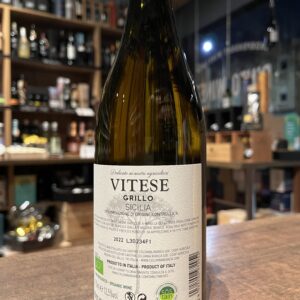
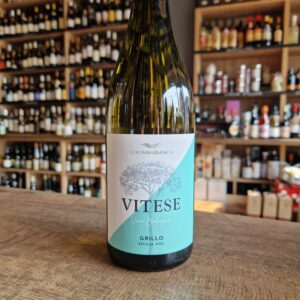 The Colomba Bianca winery was founded in 1970. During the last 10 years, under the guidance of our Chairman Leonardo Taschetta, it has become the biggest wine growing co-operative in Sicily. The company today, can, in fact, count on circa 2480 partners and extends along 7500 hectars of vineyards between the provinces of Trapani, Palermo, Agrigento, Caltanissetta e Ragusa, with 5 wineries distributed in the whole territory. The vineyards can be found in areas which benefit of a vast pedoclimatic diversity, from the low coastal areas up to an altitude of 600 metres above sea level. "We work with the aim that our farmers receive the right compensation for their work. This adds dignity to Sicilian agriculture and to the wines which express at best our territory. It is for this reason that each one of our wines is dedicated to our farmers." - Colomba Bianco Grillo is the flagship of Sicily's indigenous white varieties. Famous for its role in the production of Marsala wines, but has recently come into its own as a varietal making light, fresh and citrussy wines. Ideal with fish first courses, delicate risottos and white meat dishes.
The Colomba Bianca winery was founded in 1970. During the last 10 years, under the guidance of our Chairman Leonardo Taschetta, it has become the biggest wine growing co-operative in Sicily. The company today, can, in fact, count on circa 2480 partners and extends along 7500 hectars of vineyards between the provinces of Trapani, Palermo, Agrigento, Caltanissetta e Ragusa, with 5 wineries distributed in the whole territory. The vineyards can be found in areas which benefit of a vast pedoclimatic diversity, from the low coastal areas up to an altitude of 600 metres above sea level. "We work with the aim that our farmers receive the right compensation for their work. This adds dignity to Sicilian agriculture and to the wines which express at best our territory. It is for this reason that each one of our wines is dedicated to our farmers." - Colomba Bianco Grillo is the flagship of Sicily's indigenous white varieties. Famous for its role in the production of Marsala wines, but has recently come into its own as a varietal making light, fresh and citrussy wines. Ideal with fish first courses, delicate risottos and white meat dishes. -
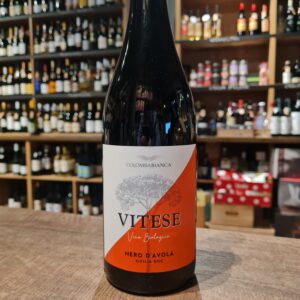 Vitese Nero D'Avola is an organic and vegan wine. It is an intense ruby red with a bouquet very fruity with scents of red berries (cherry, blackberry), fragrant, mineral (graphite), spicy. In the mouth it presents a perfect balance of tannins and acidity, profound taste of great extent and structure, elevated smoothness. Intense, persistent and fine. Pairs well with aperitifs, mature cheese and Ragusano DOP, cold cuts, maialino from the Nebrodi mountains, white and red meats.
Vitese Nero D'Avola is an organic and vegan wine. It is an intense ruby red with a bouquet very fruity with scents of red berries (cherry, blackberry), fragrant, mineral (graphite), spicy. In the mouth it presents a perfect balance of tannins and acidity, profound taste of great extent and structure, elevated smoothness. Intense, persistent and fine. Pairs well with aperitifs, mature cheese and Ragusano DOP, cold cuts, maialino from the Nebrodi mountains, white and red meats. -
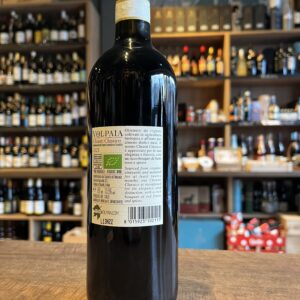
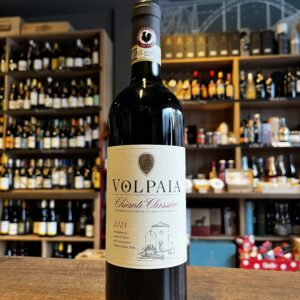 The oldest Italian Wine appellation. The first official document citing the Chianti wine is dated 1398. But it’s only in 1716 that the Granduke of Florence Cosimo III de’ Medici officialy sets the boundaries of the Chianti region where Chianti Classico wine is now produced (but not Chianti wine). Since 2007 Chianti Classico is made with up to 100% of Sangiovese and no more than 20% of other authorized red berry varieties of wich none should exceed 15% alone.
The oldest Italian Wine appellation. The first official document citing the Chianti wine is dated 1398. But it’s only in 1716 that the Granduke of Florence Cosimo III de’ Medici officialy sets the boundaries of the Chianti region where Chianti Classico wine is now produced (but not Chianti wine). Since 2007 Chianti Classico is made with up to 100% of Sangiovese and no more than 20% of other authorized red berry varieties of wich none should exceed 15% alone. -
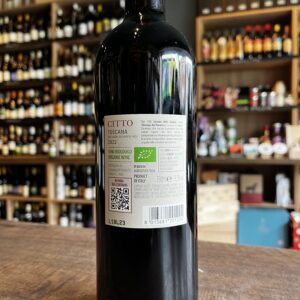
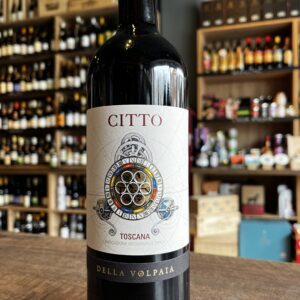 Castello di Volpaia overlooks the village of Radda in Chianti. The town was built in the 11th century as a fortified village on the border of Florence and Sienna. Although only part of the original protective walls and two of its six towers are still standing, the medieval layout and buildings within the village are still intact, making Volpaia one of the best preserved villages of its period. Just as it has been for the last 900 years, the entire village is intimately involved in the production of wine and olive oil. The cellars, bottling plant, barrels and olive press are nestled within the original stone walls that have been carefully restored by owners Carlo Mascheroni and Giovanella Stianti Mascheroni and their children, Nicolo and Federica. The nearly 114 acres of vineyards owned by Castello di Volpaia are at 1,300-2,130 feet above sea level, making Volpaia the highest winery in the Chianti region. The land is comprised of soils consisting largely of sandstone and a sedimentary rock from the Pliocene era. Citto is made from a selection of the best grapes from our IGT vineyards in the Chianti Classico and Maremma areas In the Tuscan dialect Citto means young boy. As from the land in comes from Citto is the young boy of Volpaia.As in the French tradition of the great Bordeaux Chateaux Chateau Mouton Rotschild has Mouton Cadet and Chateau Cheval Blanc has Petit Cheval, the same way Castello di Volpaia has his Citto. Pair with red meats and charcuterie
Castello di Volpaia overlooks the village of Radda in Chianti. The town was built in the 11th century as a fortified village on the border of Florence and Sienna. Although only part of the original protective walls and two of its six towers are still standing, the medieval layout and buildings within the village are still intact, making Volpaia one of the best preserved villages of its period. Just as it has been for the last 900 years, the entire village is intimately involved in the production of wine and olive oil. The cellars, bottling plant, barrels and olive press are nestled within the original stone walls that have been carefully restored by owners Carlo Mascheroni and Giovanella Stianti Mascheroni and their children, Nicolo and Federica. The nearly 114 acres of vineyards owned by Castello di Volpaia are at 1,300-2,130 feet above sea level, making Volpaia the highest winery in the Chianti region. The land is comprised of soils consisting largely of sandstone and a sedimentary rock from the Pliocene era. Citto is made from a selection of the best grapes from our IGT vineyards in the Chianti Classico and Maremma areas In the Tuscan dialect Citto means young boy. As from the land in comes from Citto is the young boy of Volpaia.As in the French tradition of the great Bordeaux Chateaux Chateau Mouton Rotschild has Mouton Cadet and Chateau Cheval Blanc has Petit Cheval, the same way Castello di Volpaia has his Citto. Pair with red meats and charcuterie -
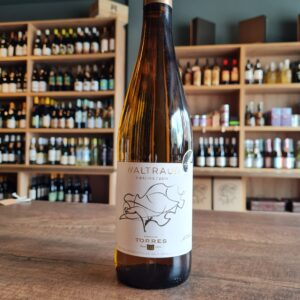 Waltraud is made with the best harvests of Riesling, which is one of the most highly prized aromatic varieties - and rightly so given that it is capable of producing such an elegantly sublime and magnificently fruity wine as this. Waltraud Maczassek, of German nationality, put down roots in the Penedès region when she married Miguel A. Torres. That's why he decided to make a wine in her honour, using German varieties but planted in the Upper Penedes. The wine has a luminous gold color. On the nose reminiscent of orange blossom, jasmine, quince and pineapple. Elegant, firm-bodied and silky, with echoes of spice bread on the finish. Pairs beautifully with oysters and shellfish. Sublime in combination with fish, rice dishes, pasta with mariniere sauce, duck in sweet sauce.
Waltraud is made with the best harvests of Riesling, which is one of the most highly prized aromatic varieties - and rightly so given that it is capable of producing such an elegantly sublime and magnificently fruity wine as this. Waltraud Maczassek, of German nationality, put down roots in the Penedès region when she married Miguel A. Torres. That's why he decided to make a wine in her honour, using German varieties but planted in the Upper Penedes. The wine has a luminous gold color. On the nose reminiscent of orange blossom, jasmine, quince and pineapple. Elegant, firm-bodied and silky, with echoes of spice bread on the finish. Pairs beautifully with oysters and shellfish. Sublime in combination with fish, rice dishes, pasta with mariniere sauce, duck in sweet sauce.


